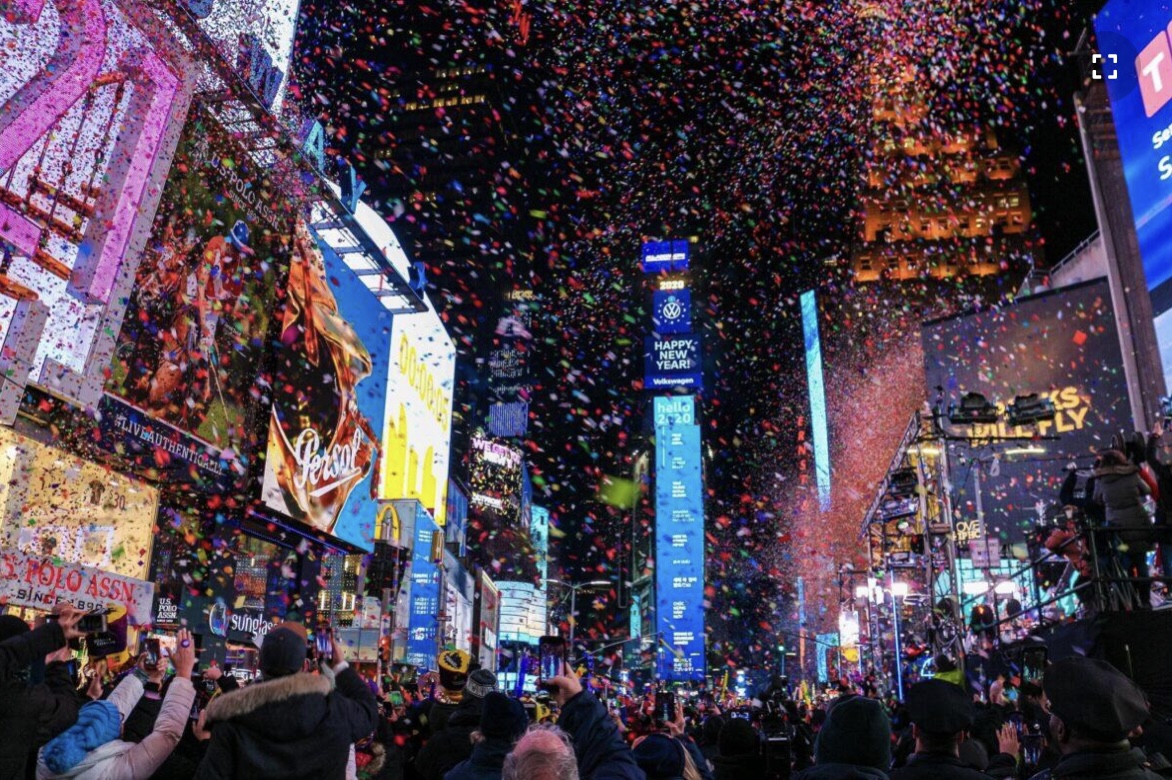Changes on how to celebrate New Years Eve due to Covid.
Changes on how to celebrate New Years Eve due to Covid.

New York
Millions of spectators let their hair loose at the New Year’s Eve Ball Drop in Times Square. The tradition is more than a hundred years old—the ball was first lowered at the party hotspot in 1907. And it’s not just the ball drop at 11:59 p.m. or the confetti, there are musical performances organized every year and it’s a big street party. Hotels and restaurants at Times Square with a view fill up—at a great cost—months in advance!
This year, a century-old event will be very different. Due to COVID-19, the iconic event will be held virtually. Revelers can participate in the celebrations through an app, and there will be in-person honorees (most likely first-responders and medical professionals) who will be part of the small-scale celebrations at Times Square.
Tim Tompkins, President of the Times Square Alliance, said in a statement, “One thing that will never change is the ticking of time and the arrival of a New Year at midnight on December 31. But this year there will be significantly new and enhanced virtual, visual, and digital offerings to complement whatever limited live entertainment or experiences—still in development—will take place in Times Square.”
With police blocking it off, Times Square will be inaccessible to the public on New Year’s Eve.

Madrid
Spain’s capital city is one of the latest to cancel its traditional New Year’s Eve celebrations.
Every year, thousands of people gather in the main public square, Puerta del Sol, on December 31, and eat 12 grapes as the bell chimes 12 times. The clock at the Real Casa de Correos (an 18th-century building which is now the seat of the Presidency of Community of Madrid) is famous for this New Year’s tradition and the bell’s teals are televised all over Spain. And the street party begins once you’ve consumed the grapes for good luck—there are fireworks, champagne or cava, music, and dancing.
But the tourism board recently shared that this year will be different, “Due to COVID, the traditional New Year’s chimes can only be followed this year on television, since the Community of Madrid has prohibited the celebration of New Year’s Eve chimes in 2020 at Puerta del Sol and in the rest of the squares.”

Geneva
The New Year’s Eve street party at the waterfront Quai du Mont-Blanc is also out of the picture this year. The festivities include fireworks at the harbor, live concerts and DJs along three stages, and food stands. The City of Geneva said on its website that it wouldn’t be possible to maintain social distancing measures for a gathering with thousands. “It is therefore impossible to organize such a large-scale event bringing together tens of thousands of participants and involving concerts, refreshments stands, entertainment, and other stands,” it says.

Las Vegas
There are more than 80,000 fireworks that go off in Las Vegas, entertaining a group of over 300,000 people, among other events in the city to ring in the new year.
The Las Vegas Convention and Visitors Authority has announced that it’s canceling the pyrotechnics display that’s the highlight on the Strip every December 31. However, there is a virtual celebration planned for revelers to kiss goodbye 2020.
The virtual party will include a 2020 sign that will be blown up, followed by fireworks, streamers, confetti, and a DJ to ring in the new year. Travelers may be participating from home, but there is a chance to win a trip to Vegas in 2021 (details are here).
Steve Hill, CEO of LVCVA, said in a statement that celebrating the new year in Vegas is a long-held tradition. “Although many visitors from around the country and the world will not be able to join us in person to turn the calendar, this virtual event will allow us to share our enthusiasm and excitement with Vegas fans near and far as we look toward a brighter 2021,” he quoted.

Rio de Janeiro
Around 3 million people rang in 2020 on Copacabana beach, partying, dancing, and watching 14 minutes of fireworks. It’s one of the biggest and most popular New Year’s Eve celebrations in the world and this year, it will be canceled. Instead, the celebrations will be taken online, with a light show and performances at locations with no public.
Another major event for the city, Rio’s Carnival is also scrapped—for the first time since 1912 when it was delayed by two months. The event happens in February and brings millions to the city, so it’s really important for tourism. Interestingly, the show even went on during World War II, but it won’t be safe right now, given that Brazil has 5.5 million cases.

London
For almost two decades, London has hosted one of the craziest street parties along the Thames on New Year’s Eve. Around 100,000 spectators line up on the Victoria Embankment to see around 2,000 fireworks that light up the skies over Big Ben. Since 2014, the event has been ticketed and in 2018, the show cost $2.9 million.
This year, the Mayor of London, Sadiq Khan, has announced that the event is canceled. He told LBC, “We simply can’t afford to have the numbers of people who congregate on New Year’s Eve, congregating.” However, he also mentioned that the city will organize something that revelers can enjoy from home.
Around 12 million people watch the show on TV and he explained, “We can’t afford to lose that slot because New Year’s Eve is a really great opportunity for the rest of the world to see how wonderful our city is. Particularly during a recession, we need to continue [investing] in our city and people coming to London.”

Dublin
Another city to incur major financial loss due to the cancelation of New Year’s Eve celebrations will be Dublin. Fáílte Ireland (National Tourism Development Authority of Ireland) has announced that it has decided to ax the festivities, which draws a crowd of 110,000 over three days (80,000 just to watch the fireworks display).
“Given these numbers, it is clear that the event would not fall within current Government and public health guidance and it would not be appropriate to encourage people to congregate in these numbers,” the statement said.

Sydney
Last year, Australia was fighting bushfires and, in the haze of the smog, the skies lit up for the hopes of a better tomorrow—even though there were several pleas to cancel them out of respect for the communities fighting the fires. This year, too, the fireworks are still on, but a few things have changed.
For one, there will be no 9 p.m. fireworks for the kids. The midnight show will be reduced from its 12 minutes and it will focus on the Sydney Harbour Bridge, scaling it down from several other locations. Over a million locals and tourists come to see this show, but this year they will be encouraged to watch it on TV, and there will be fewer viewing sites. So, the cost this year will come down from the $6.5 million it took last year.
Additionally, the celebrations will be run by the state government instead of the city. “Tourism Minister Stuart Ayres has assured me that the State Government will take full responsibility for preparations and funding of the fireworks, crowd management, safety, traffic and transport, and is prepared to cancel the event if there is a spike in COVID cases,” Sydney Lord Mayor Clover Moore said.

Vienna
The city erupts into a mass party every year. The event, called Silvesterpfad, translates into “New Year’s Eve Trail”, and it is so much more, with activities all day and lasting until 2 a.m. New Year’s Day. You see bands, orchestras, performances, and fireworks at midnight in City Hall Square. There’s also a communal waltz around St. Stephen’s Cathedral, where 12 chimes of the bell mark the change of the year. In 2019, there were 800,000 who celebrated the trail and all its festivities.
This year, the city is taking a break from the event due to the pandemic. “Normally, the entire city center transforms into a giant party site on December 31 for the New Year’s Eve Trail. Because of Corona, this Viennese institution must take a break this year,” the tourism website informed.
However, there are other private events planned in the city (operas, exhibitions, and galas at hotels and bars), and Vienna Philharmonic New Year’s Concert will be broadcasted to 50 million viewers around the world, as is the tradition.
Related




















